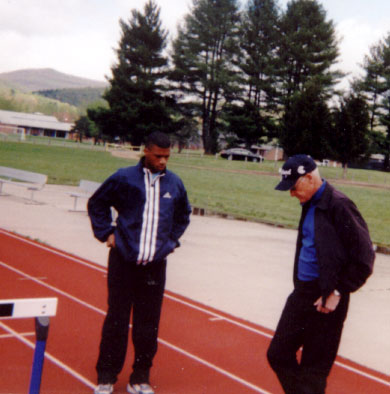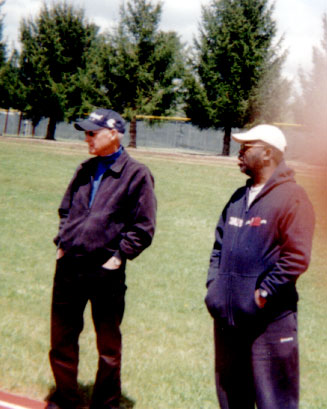A couple months ago – April 23rd, 2005, to be exact – I traveled to the quiet town of Brevard in the mountains of Western North Carolina to meet with Jean Poquette, the high school coach of the legendary Renaldo Nehemiah. Myself, along with my coaching partners, Aaron McDougal and Troy Baker, made the four-hour drive together as Johnny Dutch – one of the best high school hurdlers in the United States – slept in the backseat. McDougal, who has coached the 16-year-old Dutch in youth track ever since Dutch was a little nine-year-old playing in the long jump pit while his older sister practiced, agreed that we should make the pilgrimage when I mentioned the possibility to him, noting that having a chance to gain wisdom from a master coach was an opportunity we would be foolish to let pass by. So, the four of us journeyed to Brevard with the purpose of having Coach Poquette critique Johnny’s technique, to gain some insights on what direction we should go in regarding his training, and to just talk track.
It was a sunny but windy day in Brevard – about 65 degrees, with the wind making it feel about five degrees cooler. When we pulled into the parking lot adjacent to the track, we got out and waited for Coach Poquette to arrive, as he had instructed us to meet him there. While waiting, we took a look at the track, and noted that the Brevard College eight-lane oval had a soft, rubber surface that would be kind to Johnny’s legs. Although the weather was relatively pleasant, there was no one else out on the track, which was a good thing, because it meant we would have it all to ourselves. When Coach Poquette did appear – about five minutes after we did – it wasn’t difficult to tell he was the man we were waiting for. In spite of his sixty-eight years, he looked fit, trim, and athletic. Wearing a dark blue baseball cap, sunglasses, a navy blue turtleneck, and a dark blue jacket and pants, he greeted us warmly, thanked us for coming, and then asked us to help him set up some hurdles, which we did, as Johnny began to warm up.

Coach Poquette giving technical advice to hurdler Johnny Dutch.
Coach Poquette had Johnny – a sophomore at Clayton High School in Clayton, NC – do the infamous back-and-forth workout, in which five hurdles are set up in one direction, and five more are set up beside them, facing the other direction. However, Johnny only had to do a modified version of the workout, with only five hurdles set up, but none heading in the other direction. Coach Poquette didn’t really want to work Johnny hard; he just wanted to get a feel for his hurdling technique and identify any technical flaws he may need to correct. Watching Coach Poquette coach Johnny served as a better coaching clinic than any actual coaching clinic could ever be. Having used many of Coach Poquette’s workouts myself as both a coach and an athlete, seeing him “in action,” so to speak, truly brought the workouts to life, as they seemed to literally leap from the textbook or the video screen directly onto the track. The following observations in particular caught my attention during the practice session:
· I gained a much clearer idea of how useful it is for the coach to be actively involved in the workout at every moment. Coach Poquette provided vocal instruction for Johnny not just during every rep, but at just about every hurdle. The sound of Coach yelling “Snap!” still rings in my ears. What I noticed, though, is that Coach wasn’t yelling to just be yelling, but to provide the reminder that Johnny needed to keep snapping down his lead leg at every hurdle, no matter how tired he was getting. When he was yelling, he was yelling instructions, not yelling orders. Coach, in effect, was serving as the voice in Johnny’s head – the voice that he wouldn’t have to hear out loud on race day because he would have heard it so many times during practice sessions. I’ve always known Johnny to have a very fast lead leg, but watching him do that workout under Coach Poquette’s instruction was an eye-opener for me; with Coach yelling “Snap!” all day long, Johnny’s lead leg was snapping down so fast that I could hardly see it.
· If it’s broke, fix it. Do not allow an improper mechanic become habit. On more than one rep, Coach Poquette stopped Johnny before he even got through all five hurdles, letting him know that he wasn’t snapping down with enough force, or that he wasn’t approaching the first hurdle with enough speed. Coach’s point was that you can’t waste a rep, you can’t even waste a hurdle; you have to give total mental attention to every hurdle you clear. “No, no, that’s too slow,” Coach would say, stepping into the lane, “Go back and do it again.” To Coach Poquette, quantity without quality is a waste of time. Even worse, it is counterproductive, because a large quantity of bad habits only ingrains the bad habits, making them even more difficult to correct when the time comes.
· What stood out to me in regards to the nature of the back-and-forth workout was that the five steps between the hurdles are not an even five steps at all; it’s really a three-step rhythm, because the first two steps off the hurdle are recovery steps, on the balls of the feet, but with no real power or speed behind them. Also, in the Track & Field Omnibook, where I had originally read about the workout, it said that the hurdles should be set ten yards apart, but Poquette says the hurdles should actually be twelve yards apart in order to allow room for the two recovery steps, and then the three fast, driving steps into the next hurdle. He did not use a tape measure to mark off the distance, but used his feet, with six toe-to-heel steps from the regular mark for a total of two yards from the regular mark of the second hurdle, then twelve steps from the regular mark for the third hurdle, etc. Because the snapdown is so forceful, the two recovery steps are a necessity, not a luxury.
· It takes a while for the athlete to get the specifics of the five-step rhythm of the back-and-forth workout. The tendency is to count the snapdown step as the first step, and to then take four driving steps into the next hurdle. But once you get the rhythm of the workout, the two recovery steps are, indeed, very helpful, as they enable you to re-fuel, so to speak, and power into the next hurdle. Since visiting Coach Poquette, I’ve had several athletes do this workout, emphasizing the importance of taking the two recovery steps. I’ve noticed that the first thing to go when fatigue sets in is the rhythm, and then, consequently, the forcefulness of the snapdown. The athletes generally will begin to revert back to an evenly-paced five steps, as opposed to the one-two, threefourfive! that provides the necessary velocity going into the hurdle. When that happens, it is my role as coach to step forward, abort the rep, and remind the athlete to maintain the rhythm of the workout.
· It doesn’t feel “normal” or “right” to snap down with that much force; it takes some getting used to, because you feel like you’re being propelled into the next hurdle. It is now clear to me how, if Nehemiah was snapping down that with that much velocity and force over and over again in practice sessions, he was able to develop such flawless technique as he had.
· The lead leg truly is the key to fast, efficient hurdling. These days, there seems to be a larger emphasis placed on the trail leg, and there is plenty of relevance to this approach, as many hurdlers have had success with it. But in our short visit with Coach Poquette, it became clear to me that a lead leg that clears the hurdle with velocity, force, and a proper mechanic, fixes many other technical flaws even if the athlete is not consciously focusing on those flaws. The trail leg, for instance, will naturally drive up more quickly, with more speed and force, because the force of the snapdown, in effect, yanks the trail leg upward. Then, as Coach Poquette said, all you have to do is “unitize,” or, make yourself aware of the continuous motion of both legs from take-off to landing.

Poquette showing Dutch the lead-leg knee action.
After the coaching session, Coach Poquette treated us to lunch at a Chinese buffet restaurant, where we talked about track some more, and he told us some stories about growing up in New Jersey. It was a fun trip, an informative trip, and an inspiring trip. Coach McDougal said that he “found it highly informative because it basically reinforced the fact that there’s a number of ways to do things, but there’s only one end result. There’s only one way that it should end up. What you’re trying to accomplish mechanically should happen. The experience of [Coach Poquette’s] years led him to where he is, and he was willing to share that with us because he saw what we were trying to do. We don’t have to try to reinvent the wheel, we just gotta get the wheel rolling. Like he said, it ain’t just about going fast; it’s about developing the whole person, rather than just the athlete.”

Poquette and Aaron McDougal observing Dutch’s technique.
Before our visit with Coach Poquette, Johnny, who co-owns the national freshman 110m hurdle record with a 14.16, and broke the national sophomore record this past March in the 55m and 60m hurdles, held a personal best in the 110’s of 14.11. Since our visit with Coach Poquette, Johnny has run under 14.00 twice in the 110’s, with a personal best of 13.77, which currently ranks him as fifth in the nation. He will be competing this weekend at the Nike Outdoor National Championships in Greensboro, NC, where he plans to compete for the 110m title. Although Dutch wasn’t even born yet when Nehemiah was competing, he appreciates the significance of having Coach Poquette critique his technique. “That’s the man, right there,” he said. “He coached the best ever.” Dutch elaborated by saying that Coach Poquette is “a very, very wise man. I learned so much from him in just that one day. I learned how to be quicker between the hurdles, how to get my lead leg back on the ground quicker, and also how to stay focused. It was cool because, so many things that he taught Nehemiah, he was teaching me. I felt really blessed that he would spend his time with me, because he’s one of the best hurdle coaches in the world.”
© 2005 Steve McGill
